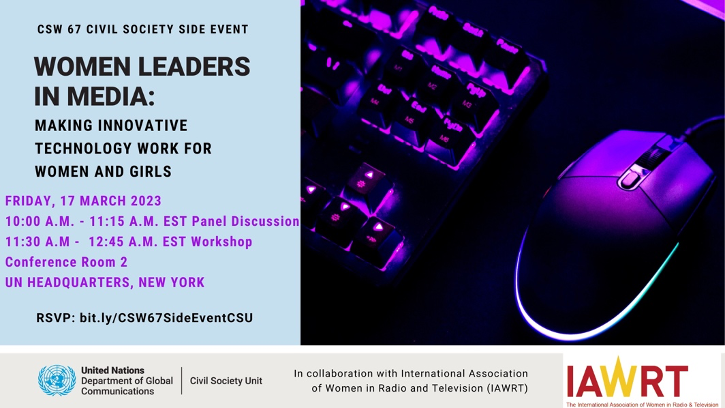Women Leaders in Media: Making Innovative Technology Work for Women and Girls
Written by Nancy Cohen and Sheila Katzman
Editors: Frieda Werden, SME, HK
Organized by IAWRT-USA partnering with the United Nations Department of Global Communications (UNDGC), this side event was held at the UN Headquarters, New York on 17 March 2023. The objective of this panel discussion was to activate an international women’s network of thought and action leaders to work toward developing inclusive communication strategies, share information and know-how about the technologies women work with and invite participants to see how the technologies can also work for them. This event builds on the theme of CSW67, which was “Innovation and technological change, and education in the digital age for achieving gender equality and the empowerment of all women and girls.”
IAWRT as an accredited body to the UN undertakes collaborative activities with several of its bodies as exemplified by the hosting of this event with the UNDGC. Being partners in this endeavour ensures that we are in a position to influence international policies that will impact the lives of women and girls.
As an international organisation for women journalists, IAWRT is acutely aware of the potential impacts that innovations in artificial intelligence (AI) could have on women and girls. The opportunity to co-host this event provided the catalyst for IAWRT-USA to bring specialists together to examine and deepen understanding of the positive and negative aspects, likely changes to the profession and the role of journalists and how to prepare for the future.
Panel Discussion

The event brought together experts from various media sectors to discuss the impacts, problems and the likely future we want for women in a technological world.
Award-Winning journalist, Jane Tillman Irving, whose achievements include being the first Black female reporter at WCBS Radio-AM/News Radio 880, New York City and immediate past President of the New York Press Club moderated the session. She highlighted the speed with which our lives have changed technologically, reminding the younger members of the audience that at one time there was no Google everyone used encyclopedias for research. However, no matter the technological advancements, it still comes down to one thing for journalists – getting the story, telling the truth and doing it as quickly as possible. She stated that the aim of the panel was to address measures that are needed to prevent women and girls from being left behind during this rapidly evolving technological era.

The panel members were, from L-R:
- Dr. Patrice S. Johnson, Chief Program Officer for Black Girls Code (BGC)
- Dr. Michelle Ferrier, President of IAWRT
- Mia Shah-Dand, CEO – Lighthouse3 and Founder – Women in AI Ethics
- Jane Tillman Irving, award-winning journalist, first Black female reporter at WCBS Radio-AM/News Radio 880
- Leah Mann, Communications and Community Management Office, Broadband Commission for Sustainable Development – International Telecommunication Union (ITU)
- Karin Orantes, Acting Chief of UN Social Media Team
- Dr. Dijana Jelača, Cinema Studies Professor, Brooklyn College and survivor of the Bosnian War
Each panelist gave an overview from their perspective during the first half of the meeting and shared their focus for 2023. An interactive session followed their statements, which gave the audience the opportunity to dig deep into some of the more contentious issues that were highlighted by the panel.

Leah Mann, in discussing the role of ITU in the digital sphere and Artificial Intelligence (AI), cited statistics showing the disparity in access to digital technologies between the genders.[1],[2] There are still many people who are not online and of those who are, an estimated 69 percent worldwide online are men, compared to 63 percent of women and girls. She argued that to change the stereotype of who can participate in the digital world, a) we need to see more women in prominent roles, b) narrow the gaps in digital skills and education by offering women and girls the chance to participate in the STEM [Science, Technology, Engineering, and Math] world. April 27th is ITU International Girls and ICT Day which is one of the initiatives to raise awareness, empower, and encourage girls and women to pursue studies and careers in STEM. 377,000 have taken part in over 11,000 celebrations in 171 countries. The ITU is integral to the shape of global digital technological coverage and access.
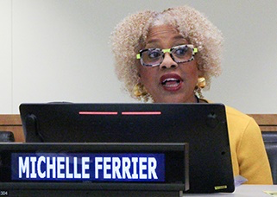
Dr. Michelle Ferrier[3] spoke on the issue of protection from online media abuse, a subject she knows much about, having been herself subjected to harassment while teaching. In response, she created TrollBusters, an organization that supports women who experience online harm.[4] She is also involved with Toxic Avengers, a magazine that explores digital harm and ways to protect the writer. She created the Media Innovation Collaborator programme helping journalists, media workers and communicators understand the technological environment and how to navigate the digital landscape. In Ethiopia, she is working to build an independent media sector of journalists united across the country to support each other and their communities bringing local news that impacts them. Dr. Ferrier told the audience that IAWRT is at the forefront of developing innovative approaches in response to the ongoing abuse of many of its members. Responding to the wrongful arrest and imprisonment of IAWRT communications officer, Lady Ann Salem in 2020, IAWRT established a Digital Safe House in the Philippines as a pilot program.[5] This has become a prototype for other IAWRT chapters in countries where journalists are under constant threat.
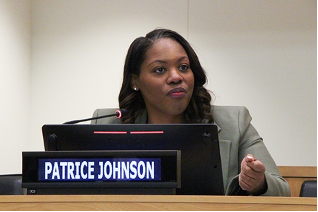
Dr. Patrice S. Johnson described the Black Girls Code (BGC) is an organization that helps thousands of black girls to discover and embark on computer programming careers, while using digital technologies to enhance their natural leadership skills. She introduced three of the girls who have been in the program since the first grade. If BGC can challenge the world of digital technology, they can challenge any industry, she said; she reminded us that when Black girls are liberated, we are all liberated.
Three Black Girls Code student ambassadors shared their personal stories. Since the first grade, Madison Clarke, a 16-year-old student at East Side Community High School, has attended BGC. She was given the opportunity to ring the closing bell at the New York Stock Exchange in honour of Black History Month. That is no small feat. She mentioned how much self-assurance she had developed and how she now felt like a beloved member of a family.
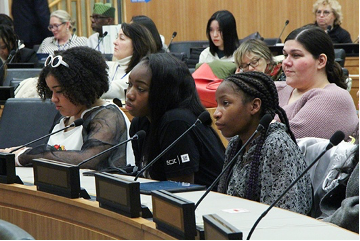
Ifeoluwa (Ife) Joseph, 12, had equally exhilarating thoughts about the Black Girls Code and being nominated by Time Magazine and Nickelodeon for Kid of the Year in 2019.
Ife, as she is fondly known, created a prototype to remove microplastics from water.
Thirteen-year-old Annyah Mchugh Butler, a veteran of BGC, who was home-schooled, said she learned to develop codes for robots and develop websites. She joined BGC when she was seven years old. In 2019, she became the youngest person ever to win the NASA SpaceX Project Person’s Choice Award.
BGC is a grassroots organization and has 15 chapters, including one in South Africa, where girls are identified, trained and nurtured to enable them to compete for exciting career opportunities. BGC is multi-tiered focusing on virtual, community-based and working in schools respectively. Many in the audience were in awe of the work of BGC and wanted to explore the possibility of developing partnerships with their home countries.
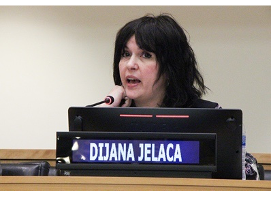
Dr. Dijana Jelača spoke on media, associated technology and trauma. She pointed out that whoever invents new technologies should make them accessible to different groups, not only the groups associated with the specific innovation. Take photography for example, when invented, it favored capturing people with white skin, which embedded a bias with an accompanying notion of privilege that white is best. Several decades later we are still trying to alter this aberration.
Jelača noted how women’s influence in telecommunication technologies has been buried. The Lumière brothers are credited with inventing narrative films; yet Alice Guy-Blache, an early film pioneer, actually made the first known narrative film. She has been ignored in many film histories. Women and girls must be acknowledged.
Dr. Jelača also addressed the philosophy underpinning digital technologies and raised pertinent questions. For instance, how do we make film screens bear witness in ethical ways – not only showing an image of suffering but inspiring people to do something about it? Whose suffering gets ‘air’ time? She drew attention to how white Europeans in the present wars are getting the attention that victims of other brutalities have not. Jane Tillman Irving illustrated Dr. Jelača’s point by mentioning a question a media person asked about the Ukraine war: “How could this be happening in a ‘civilized [white] country’”? She was shocked to report that this unnamed person is still employed.
She stressed that there are ethical considerations attached to digital technologies and issues such as the decolonization of the digital media landscape are critical and requires immediate attention.
Dr. Jelača laments over who the creators of AI are and its possible characteristics. She questions how it can be harnessed for the public good, and how will it include disenfranchised populations. And how will it impact the lives of women and girls?

Mia Shah-Dand talked about how hard it is to balance life and work. She set up Lighthouse 3, a consulting firm for emerging digital technology developers as she wanted to bring people from outside the digital technology bubble into the domain as active participants. A longstanding problem is that men dominate most conversations in STEM-dominated industries. She said women were more than qualified but are generally overlooked. This inspired her to publish The First Hundred Brilliant Women in AI. She reiterated that the qualified women are there but are still not getting the recognition. Since 2018, Lighthouse 3 has had a database with 800 qualified women. During the pandemic, Dand launched a mentoring program to help expand the diverse community to younger members.
Most start-ups are started and financed by white men. Less than two percent of funding goes to women; less than one percent goes to Black founders. The diversity gap is because women are not in the room even when they are overqualified. This is starting to change, but now they are in the room, how can they work on projects that impact women – like facial recognition?
Technology impacts all of us, she says, and we all need to have a say in the direction it’s going. Women are the wave. She quoted the Booker Prize-winning writer Arundhati Roy, “A different world is not only possible, she is on her way, on a quiet day, I can hear her breathe.”
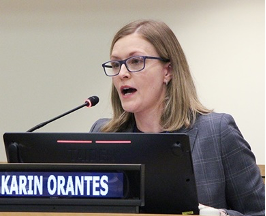
Karin Orantes said that her team runs workshops on how to use digital platforms for positive social justice. They have 38 social media platforms in nine different languages with 65 million followers. Gender equality is the most important issue. The UN Editorial practice has strict guidelines for text and visual imagery. All photographs should have women in them … not easy to achieve in an old institution like the UN. They focus on showing the power balance for visual truth and focus on highlighting women in positions of power like in peacekeeping, deputy secretaries-general, resident coordinators, and crisis situations.
They know their audiences by studying the characteristics of the platforms. Men are in the majority across all of the platforms. However, the algorithms may not be giving precise statistics; even so, they are deliberately reaching out to female audiences as there is no clear reason why it seems that the users are predominantly men.
The team uses every opportunity to feature women in stories. The role of women in climate, peacekeeping, and crises … all of these stories run throughout the editorial calendar. It helps that the Secretary-General speaks out often on gender issues. She said they ensure women are included in every image they post online.
On International Human Rights Day, 10 December 2020, the youngest IAWRT member from Afghanistan was murdered on the steps of the media house as she arrived for work in Kabul.
Key issues highlighted by the panel
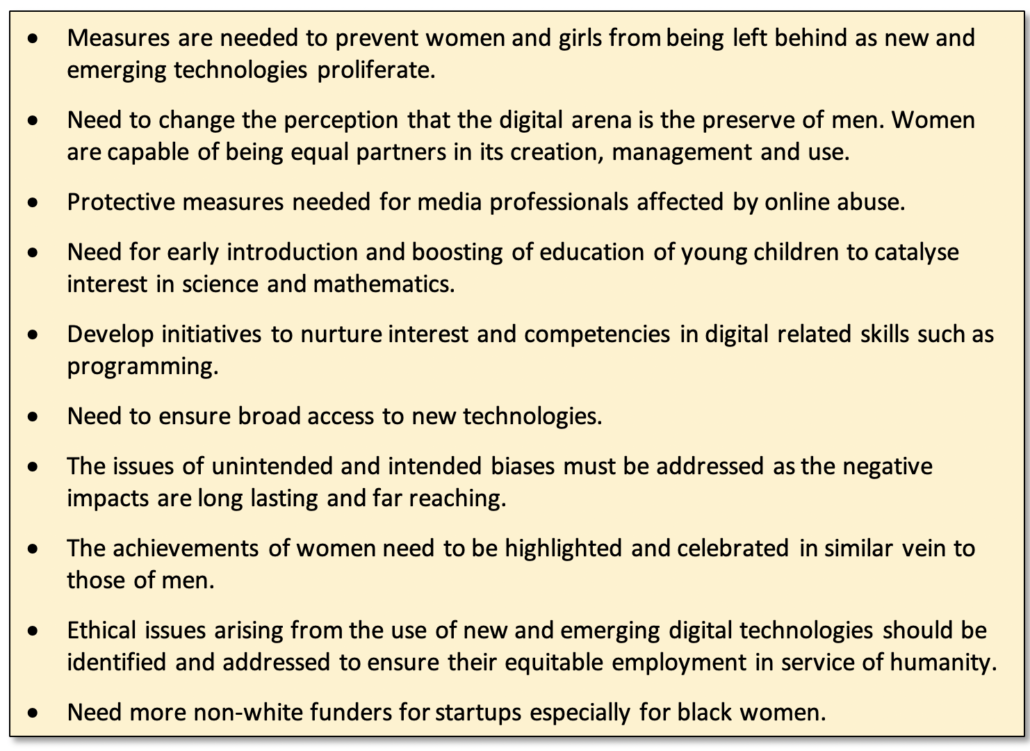
Breakout Cluster Discussions
Six groups were set up and helmed by IAWRT members who coordinated the exploration of specific questions that were submitted by the panelists. These small clusters provided opportunities for networking, sharing of information and possibilities for collaborations on a variety of activities in support of furthering the mainstreaming of women and girls in the digital space.
A question that generated much interest asked to give examples from digital media that effectively addressed an issue related to women’s rights. Responses include:
1. Hash Tag #MeToo Movement
It started in the entertainment industry and spread to the every day woman to denounce sexual violence. It encouraged women victims to speak up against Sexual Violence and showed strength in numbers when women unite their voices for a common cause.
2. Killing of Kurdish Girl Jina Amini in Iran
Galvanised women all over Iran and became a women’s protest for the fundamental rights of women.
3. In India women are using digital media to address and transform girl child education.
Conclusion
Women have been making a huge impact in the media industry, breaking down barriers and creating new opportunities for other women and girls. With the rise of innovative digital technology, women leaders in media are employing a range of digital tools to empower and uplift their communities. This event was a clear demonstration of how far we have come and where we must still strive to go.
[1] The ITU is an agency comprised of the United Nations, national governments, and private industry. Originally focused on spectrum management, ITU now also fosters expanding connectivity and digital inclusion as part of the coalition Partner2Connect (https://www.itu.int/itu-d/sites/partner2connect/)
[2] An uplifting note, on September 29, 2022, Doreen Bogdan-Martin, SIS/MA ’90, made history by becoming the first woman to hold the elected position of ITU Secretary-General in 158 years.
[3] Dr Ferrier appreciates the need for early educational boosts as she had been selected as a child to learn through the Nasa Goddard Space Center for children of color.
[4] http://www.troll-busters.com/
[5] IAWRT Digital Safe House is a one-stop or first-stop shop that links various journalists’ safety and well-being programs offered by different media groups, non-government organizations, human rights, lawyers, and church and religious groups in the Philippines. It’s the first of its kind anywhere.

